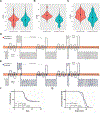CACNA1H variants are not a cause of monogenic epilepsy
- PMID: 32227660
- PMCID: PMC7301766
- DOI: 10.1002/humu.24017
CACNA1H variants are not a cause of monogenic epilepsy
Abstract
CACNA1H genetic variants were originally reported in a childhood absence epilepsy cohort. Subsequently, genetic testing for CACNA1H became available and is currently offered by commercial laboratories. However, the current status of CACNA1H as a monogenic cause of epilepsy is controversial, highlighted by ClinGen's recent reclassification of CACNA1H as disputed. We analyzed published CACNA1H variants and those reported in ClinVar and found none would be classified as pathogenic or likely pathogenic per the American College of Medical Genetics classification criteria. Moreover, Cacna1h did not modify survival in a Dravet Syndrome mouse model. We observed a mild increase in susceptibility to hyperthermia-induced seizures in mice with reduced Cacna1h expression. Overall, we conclude that there is limited evidence that CACNA1H is a monogenic cause of epilepsy in humans and that this gene should be removed from commercial genetic testing panels to reduce the burden of variants of uncertain significance for healthcare providers, families and patients with epilepsy.
Keywords: CACNA1H; epilepsy; genetics; ion channel; seizure.
© 2020 Wiley Periodicals, Inc.
Figures

References
Publication types
MeSH terms
Substances
Grants and funding
LinkOut - more resources
Full Text Sources

